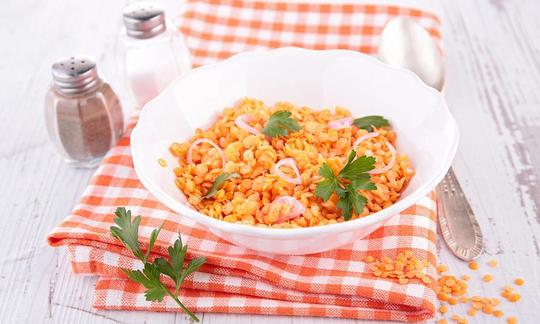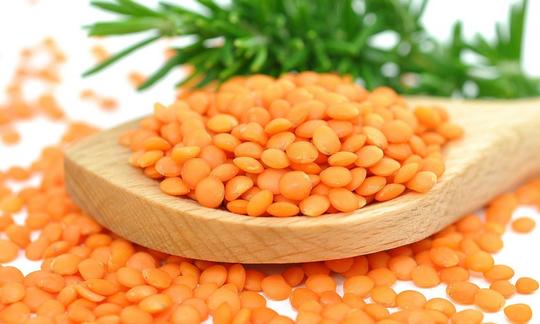Red lentils ( Lens culinaris) come from India or Turkey. These pulses are particularly well-known as the main ingredient in the national dish Dal. Since they are already peeled, they cook quickly and form a kind of porridge. There is no need to soak them beforehand.
Use in the kitchen:
Red lentils are usually peeled brown or purple lentils with an orange-red core. Unlike most other lentils, you don't need to soak them before cooking and they turn a yellowish color after cooking. Red lentils break down into a mush when cooked because they don't have a shell and absorb spices better than unpeeled lentils. They are therefore often used in stews, curries, purees, spreads or dals. A combination with rice completes these recipes in most Asian countries.
Lentils are a very good source of protein and are easier on the digestive system than beans or peas. If you puree the lentils, as in certain lentil soups, they are even easier to digest. The same applies to peeled lentils, which contain fewer flavors and nutrients than unpeeled lentils. They also have less fiber.
The rule of thumb for the consistency of cooked lentils is: the larger the variety, the faster they cook.
How many lentils for 2 people? For a pure lentil dish (e.g. dal) for two people, expect about 200 g of uncooked lentils and for a mixed dish, expect about 100-140 g of raw lentils.
Vegan recipe for red lentils with vegetables:
Simmer 300 g red (peeled) lentils in twice the amount of water for 10 minutes. In the meantime, finely chop a red or white onion and 2 cloves of garlic and sauté with a celery stick in fine rings, a tomato (chopped), a carrot and a potato (diced) in a little olive oil or rapeseed oil. If you like, you can sauté 1 tablespoon of chopped sage or add it after cooking. Then add the vegetables to the lentils and simmer everything for another 10 minutes. Finally, season with salt and pepper (and fresh sage), garnish with fresh herbs and serve. This amount is enough for 4 people.
Rapeseed oil is healthier than olive oil. For a healthy diet, it is recommended to use oil sparingly or even to avoid it altogether.
You can find a vegan recipe for a red lentil spread here.
| Not only vegans or vegetarians should read this: Vegans often eat unhealthily. Avoidable nutritional mistakes. |
Shopping - where to buy?
Cooked red lentils are occasionally available in cans. Dried red lentils are available almost everywhere. Prefer organically grown lentils. You can find dried lentils in most supermarkets such as Denns, Alnatura, Coop, Migros, Spar, Rewe, Edeka and also Denner, Volg, Aldi, Lidl or Hofer. Of course, red lentils can also be bought in organic shops, organic supermarkets (such as Denn's Biomarkt, Alnatura) or health food stores.
The different types of lentils, which are uniformly round and flat, differ not only in size but also in color. They are available peeled or unpeeled. The smallest, known as sugar lentils, measure 4-5 mm. Medium-sized lentils have a diameter of 5-6 mm and plate lentils are between 6 and 7 mm in size. Even larger specimens are called giant lentils. Red lentils are usually smaller than green lentils.
If you go by color, a distinction based on the color of the kernel is widespread, especially in the agricultural sector. This separates green lentils (with yellow or green kernels) from red lentils (with red, orange or yellow kernels). Green lentils have a green seed coat, while red lentils have a darker one (depending on the country of origin). 2,3 For this reason, the trade also likes to refer to them as "brown" or "black lentils" and only the peeled, red or orange kernels as "red lentils".
Homemade preparation:
Red and yellow lentils from the supermarket are almost always peeled. Unpeeled red lentils have a darker seed coat (brown, grey, purple, black) and should therefore be handled like all unpeeled raw lentils. Since the naming is not strictly regulated, confusion often arises (see the "Shopping" chapter).
Before cooking, peeled red lentils should be washed well under running water and drained. You can then either sauté the lentils with onions and/or garlic, add water and bring to the boil - or put them directly in fresh water and bring to the boil (we recommend cooking without salt). Then reduce the temperature and cook the lentils for 10-15 minutes.
Storage:
Dried lentils have a particularly long shelf life when stored airtight in a dark, dry place. Close open packages if possible to ensure that there is no risk of infestation by storage pests (such as moths).
Cooked, preserved lentils in a jar or tin can be kept for several years if kept closed at cool temperatures and in the dark. Some of the vitamins are lost through sterilization (heating under pressure) during the processing of canned products, but this has no effect on the other ingredients. Since pulses do not contain many vitamins anyway, the loss of some of the vitamins is probably of lesser importance - provided that you do not eat them exclusively. If the canned goods are opened, be sure to remove the lentils from the metal container, store them in the refrigerator and use them as soon as possible.
If you have cooked too large a portion of a lentil dish, you should refrigerate or freeze the rest as quickly as possible. Germs can develop not only when reheating, but when stored incorrectly immediately after cooking. Cooked lentils will last up to 4 days in a sealed container in the refrigerator. Up to 6 months frozen. Lentils and other pulses can be reheated very well. Make sure the temperature is at least 70 °C and stir frequently. 4
Ingredients - nutritional value - calories:
Lentils have a very high protein content of 25-30% in the dry matter, which is why they are very popular and valuable, especially for vegan diets. Unpeeled lentils have the advantage of containing more nutrients, as most of the nutrients and a large part of the aroma are in the shell, which also makes them taste more intense. Due to the high fiber content, unpeeled lentils are very filling, whereas peeled ones are more digestible.
How many calories are in 100 g of lentils? Cooked lentils have an energy content of 116 kcal/100g and therefore have even more calories than starch-rich potatoes (87 kcal/100g). Cooked lentils score less for their vitamin content than for their amino acids and the complex composition of carbohydrates. To increase their biological value even further, it is best to eat them in combination with wholegrain rice. 5 Only folate as a folic acid-active substance group is worth mentioning at 181 µg/100g, as 100 g of cooked lentils cover almost 91% of the average daily folic acid requirement. 1,6 This is especially important for pregnant women as their folic acid requirement is increased. Sprouted lentils provide more vitamins. For more information on the ingredients, please see the entry Lentils, raw.
Lentils contain a lot of purines, which are converted into uric acid and excreted via the kidneys - people with elevated uric acid levels should take this into account, otherwise gout symptoms can occur.
Health aspects - effects:
Which lentils are healthy? Lentils are generally very healthy, especially those with the skin on. But it also depends on digestion. If you are very sensitive, peeled lentils are more pleasant to start with than those with the skin on. Once you have gotten used to peeled lentils, you can use unpeeled ones and gradually increase the amount. The high fiber content contributes to the fact that the glycemic index of pulses is generally very low. The energy supply remains constant and so does the blood sugar level. This makes lentils ideal for diabetics.
Can you lose weight with lentils? Lentils are also an excellent food for people who are overweight and can help them lose weight without feeling hungry. 6
Secondary plant substances in the lentils (phenolic acids) help to absorb and excrete toxins from the intestines and thus reduce the risk of cancer. 7
Dangers - intolerances - side effects:
Lentils have a high purine content for plant-based foods: people with high uric acid levels or gout symptoms are advised to avoid foods rich in purines. This mainly applies to animal-based foods that contain purines. Plant-based foods can be consumed in moderation and with enjoyment. 8
Lentils are inedible in their raw form because they contain phytic acid and even toxic ingredients (eg lectins). These can be rendered harmless by cooking. Soaking and the germination process can also reduce the levels sufficiently. Science attributes both negative 9,10 and positive 11,12 effects of phytic acid on the human body.
Pulses sometimes cause unpleasant flatulence, but lentils are the least harmful; peeled lentil seeds cause even less problems. This is due to the sugars they contain, which our small intestine cannot break down because the enzymes required are missing. Bacteria in the large intestine ferment these substances, which can produce gases.
Folk medicine - natural medicine:
Lentil puree applied externally can help with gout symptoms. To do this, let the cooked, pureed lentil pulp cool, put it in a small linen bag and place it on the painful area for about 20 minutes. 5
General information:
The lentil or erve ( Lens culinaris), also called kitchen lentil, is a plant species from the genus Lens, from the subfamily Faboideae and within the family Fabaceae or Leguminosae. According to Wikipedia, it probably originates from the wild Lens orientalis. 13
Literature - Sources:
Bibliography - 13 Sources (Link to the evidence)
| 1. | Roger J. Heilkräfte der Natur. Ein Praxishandbuch. Zürich: Advent Verlag. 2006. |
| 2. | Yadav S., McNeil D. et al. Lentil: An Ancient Crop for Modern Times. Berlin: Springer Science & Business Media. 2007: 96-97; 384. |
| 3. | Samaranayaka A., Lentil. In: Nadathur S.R., Wanasundara J. et al. Sustainable Protein Sources, Elsevier. 2016. |
| 4. | Praxistipps.focus.de Bohnen nochmal aufwärmen darauf sollten Sie achten. |
| 5. | Zentrum-der-Gesundheit.de Linsen - haltbar, sehr sättigend und überdies preiswert. |
| 6. | USDA United States Department of Agriculture. |
| 7. | Russell W, Duthie G. Plant secondary metabolites and gut health: the case for phenolic acids. Proc Nutr Soc. 2011;70(3). |
| 8. | Choi HK et al. Purine-rich foods, dairy and protein intake, and the risk of gout in men. N Engl J Med. 2004 11;350(11). |
| 9. | Gupta RK, Gangoliya SS, Singh NK., Reduction of phytic acid and enhancement of bioavailable micronutrients in food grains. J Food Sci Technol. 2015 Feb;52(2):676-84. |
| 10. | Rasha K. M., Abou-Arab E.A., Gibriel A.Y., Nagwa M. et al. Effect of legume processing treatments individually or in combination on their phytic acid content. African Journal of Food Science and Technology, Vol. 2(2) pp. 036-046, February, 2011. |
| 11. | Yuan GF, Sun B, Yuan J, Wang QM., Effects of different cooking methods on health-promoting compounds of broccoli. J Zhejiang Univ Sci B. 2009 Aug;10(8):580-8. |
| 12. | Bohn L, Meyer AS, Rasmussen SK., Phytate: impact on environment and human nutrition. A challenge for molecular breeding. J Zhejiang Univ Sci B. 2008 Mar;9(3):165-91. |
| 13. | Wikipedia Linse (Botanik). |











Comments